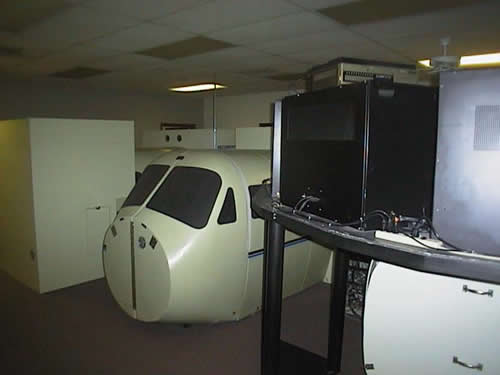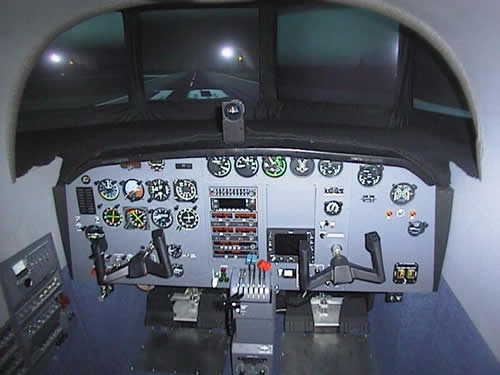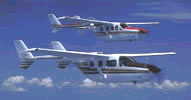
|
Recurrent Training Center: Professional Training
Do you like early Mooneys? Say 1968 or so? How about Grumman Tigers? A strange question to ask on a Skymaster web site I know, but to me, late sixties Mooneys, and Grumman Tigers, epitomize efficiency. They are not the most comfortable, they do not have the most interior room, weight capacity or range, and they have a host of other inadequacies (not enough engines), but they both do one thing well. They deliver point to point speed on less horsepower and fuel than most anything else, and they are a heck of a lot of fun! RTC is the Mooney or Grumman Tiger of simulator based training. They offer 2 1/2 days of centerline-thust simulator training and classroom instruction, your BFR, an instrument comp check, and FAA Wings credit for the miserly sum of $1085. (4 day initial training for Skymasters is $1395.) Their offices are not cushy, their instructors don't wear ties, and lunch is takeout from Subway, but the training itself is truly excellent. New Simulator If you have been to RTC before, but not recently, you should know that they have a new 337 simulator. This simulator is configurable to be either a high-performance single or a twin, by changing the throttle quadrant. The twin can be conventional or centerline thrust. They can also pop an HSI in or out, depending on how your airplane is equipped. The simulator RTC used previously for 337 training was more like a Navaho or similar aircraft. This new one is still not 100% faithful to the Skymaster in terms of speeds or power settings, but you quickly learn the different numbers, and this new sim flies much more like your bird.
LOFT The training at RTC follows the LOFT (Line Oriented Flight Training) concept. Each training module consists of two hours of classroom study via video tape and computer administered testing, and approximately 2 hours of sim time. Each sim session is one or more "flights". You get a weather briefing for each flight, and follow all your normal departure procedures as you set off for what is NEVER an uneventful flight to destinations such as Chicago Midway and Decatur in Illinois, or Colorado Springs. (By the way, another example of how RTC keeps costs and prices low is the computers they use to do the testing. When they are finished with them I'm sure their next owner will be the Smithsonian.)
RTC instructors work very hard on realism. One of my instructors (whose name I am sorry to say I forgot to record) even simulated radio chatter the controller talking to other aircraft. They do all the usual things: engine failures, partial panel, changes in cleared routing that get you behind the eight ball, etc. But more than that, they show you things that can only be done in a simulator, and really make you think about potential weaknesses in your daily flying.
Just Another Day at the Office...
Here's an example of what might be a typical RTC simulator flight. You depart Champaigne for Chicago Midway. On the departure an engine fails before the landing gear is retracted, so you land straight ahead. The instructor puts you at the end of the runway again, and on your next departure, everything works. After you get to cruise altitude, the instructor fast forwards you to a fix that seems to be fairly far from Midway. The instructor clears you to cross an intersection, which, when combined with lack of familiarity with the area, is enough to distract you into not noticing how close to the airport you are. So the approach begins earlier than expected. Now you are behind, and busier than a one-legged man in a butt-kicking contest. As you cross the marker on the ILS, the instructor sends you to tower, but if you are me, you concentrate on flying the ILS (because you are behind) and forget to call the tower. You remember your error (again if you are me) at 300 AGL, and call the tower. The tower (instructor) asks for your position and when you tell him where you are, he cancels your approach clearance and tells you to go around because there is a truck on the runway. So now you fly the missed approach, and and when you are halfway through the downwind leg, the controller calls and says the truck hit the ILS/glideslope shack in a mad dash to get off the runway, so the ILS is out of service. (A sense of humor is apparently standard equipment on RTC instructors.) Time to change your approach to another runway, find the plate, fly the airplane, set up the radios and start the new ILS to Midway again. On this approach you are starting to feel caught up when you intercept the glideslope and put the gear down. Uh oh. No greens on the gear. Break off the approach, declare an emergency and get to a safe altitude. Pump the gear down. Now ask to be vectored on to the approach again, intercept the glidelslope, and motor downwards. When you are about 50' above minimums, the runway starts to become visible when BANG all the gauges freeze and the instructor starts pounding loudly on the side of the cockpit with his fists. You just crashed... (Or at least I did.) Why? I checked the altimeter against the glideslope intercept altitude on the chart when I intercepted the glideslope, and it was 400 feet off, but I thought that was because of a sloppy intercept. Turns out the altimeter had begun to fail, and was reading 300' high. A very effective reminder of how important that fancy barometer is for our approaches. The Real World ATC Perspective
John started RTC with one simulator as a part time venture a number of years ago (calibrated by the width and flower print on his tie in one of the videos). If I remember correctly, he now has five simulators, and offers FAA approved training for all single and twin engine piston aircraft.
Hangar Flying Included Free This was my third time at RTC, and once again it afforded me the opportunity to spend time with other pilots after hours, swap stories, learn from each other, and in general just enjoy good company. This year for example, my classmates were: David Bean from Hurricane, Utah, who is a commuter airline dispatcher by day, and a P337 owner. John Dutton, an oil industry engineer and financial analyst who's company benefits include flying a Cessna 340 (I applied for work). A owner-pilot transitioning to an Aerostar. A former corporate Chief Pilot for Upjohn who drove G-IVs and G-V's for a living (now retired), and owns a Baron and a 182. Dinner with these folks was a good time, and I thank them again for their company. How to Get There RTC is in Savoy, IL. Their office is a 10 minute drive from the Champaigne, IL airport. They get you a great room rate at a local quality hotel (Hilton, I think, but who can remember...). The hotel picks you up from the airport, and delivers you to class each day, so you don't need a car. (They have Subway sandwiches brought in each day for lunch.) If you are flying in, consider Frasca Field (C16) rather than CMI. Frasca (where Frasca sims are manufactured, but not used by RTC ironically) is a smaller airport, with a less corporate atmosphere, but the fuel is cheaper, and they provided me with guaranteed hangar space for $25 per night. The FBO at CMI would not commit to hangar space at any price, and if they did hangar my airplane, it would be for something approaching $100 per night... If you are taking a cigar tube instead, flying in to Chicago is cheaper, and you can rent a car to drive to Champaigne. Insurance Company "Encouragement" In recent years, insurance companies have become increasingly insistent about recurrent training. With AIG, I was using a local flight instructor for my annual training, but when I switched to USAIG, they required sim training or they would not insure me. So RTC is providing a very valuable service: Effective, professional simulator training at prices that leave you with money to fly the airplane the rest of the year. Efficiency that would make Al Mooney proud! For more information on RTC, contact them at: http://www.avweb.com/sponsors/rtc/index.html 800-727-1014 or international 01.217.352.2787
|
Site design, software and scripts Copyright Kevin G. Mackenzie © 2002-2005 All rights reserved. This site is owned and operated by Kevin G. Mackenzie, and is not affiliated with the Skymaster Owners and Pilots Association in any way. Visible text and images are property of credited source or public domain if not credited. Disclaimer and Release: The author believes that the information presented here is generally accurate, but it is provided without any warranty. The information is presented for reference only, should not be relied upon, and should be used only to augment other information obtained from official/reliable/credible sources. If some of this information conflicts with that obtained from other sources, ignore this information. Finally, you use this information solely at your risk and, by using it, you agree to release the author from any liability.
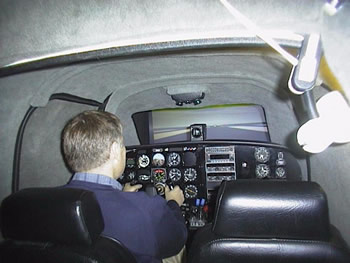 When
I bought my first Skymaster, I was looking to refurbish my instrument
skills as part of my initial training for my multi rating. (I had
been an inactive pilot for several years.) The ad at the end of
the 337 ads in Trade-A-Plane had caught my eye: "CESSNA FACTORY
APPROVED initial and recurrent simulator training for C337 Skymaster.
Fully enclosed, Skymaster simulator with full size visual. 3 day
course." Their ad tells only part of the story, and perhaps
not the best part...
When
I bought my first Skymaster, I was looking to refurbish my instrument
skills as part of my initial training for my multi rating. (I had
been an inactive pilot for several years.) The ad at the end of
the 337 ads in Trade-A-Plane had caught my eye: "CESSNA FACTORY
APPROVED initial and recurrent simulator training for C337 Skymaster.
Fully enclosed, Skymaster simulator with full size visual. 3 day
course." Their ad tells only part of the story, and perhaps
not the best part...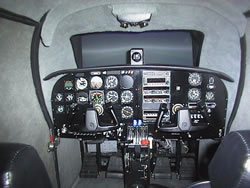
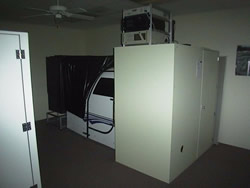
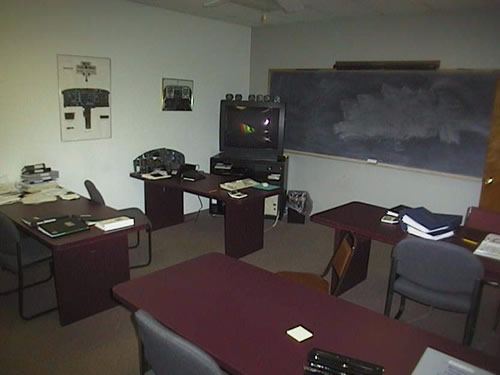
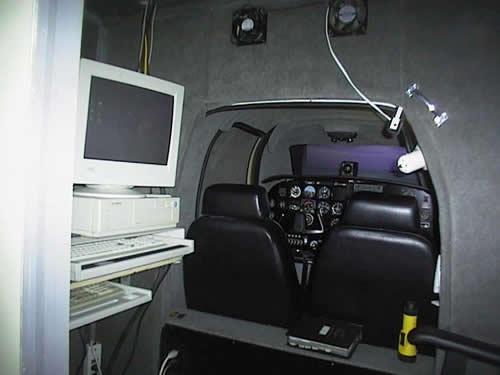
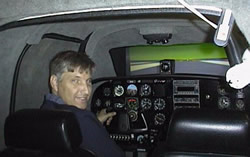
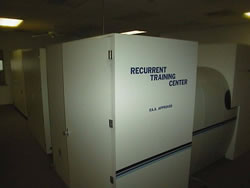 RTC
was founded and is currently owned and operated by John Killeen.
John is an experienced pilot, flight instructor, and owner (with
a partner, I believe) of two Skymasters - a normally aspirated bird
he has had for several years, and '77 P337 he recently purchased.
Until last year when he retired, John was an approach controller
for Champaigne Approach. His strong ATC experience shows through
in the ground training, with module titles like "ATC and Emergencies"
and "The ATC System". In RTC training, you learn about
the real world not only from the cockpit, but from the tower cab
and radar room.
RTC
was founded and is currently owned and operated by John Killeen.
John is an experienced pilot, flight instructor, and owner (with
a partner, I believe) of two Skymasters - a normally aspirated bird
he has had for several years, and '77 P337 he recently purchased.
Until last year when he retired, John was an approach controller
for Champaigne Approach. His strong ATC experience shows through
in the ground training, with module titles like "ATC and Emergencies"
and "The ATC System". In RTC training, you learn about
the real world not only from the cockpit, but from the tower cab
and radar room.